Page 1093 of 2543
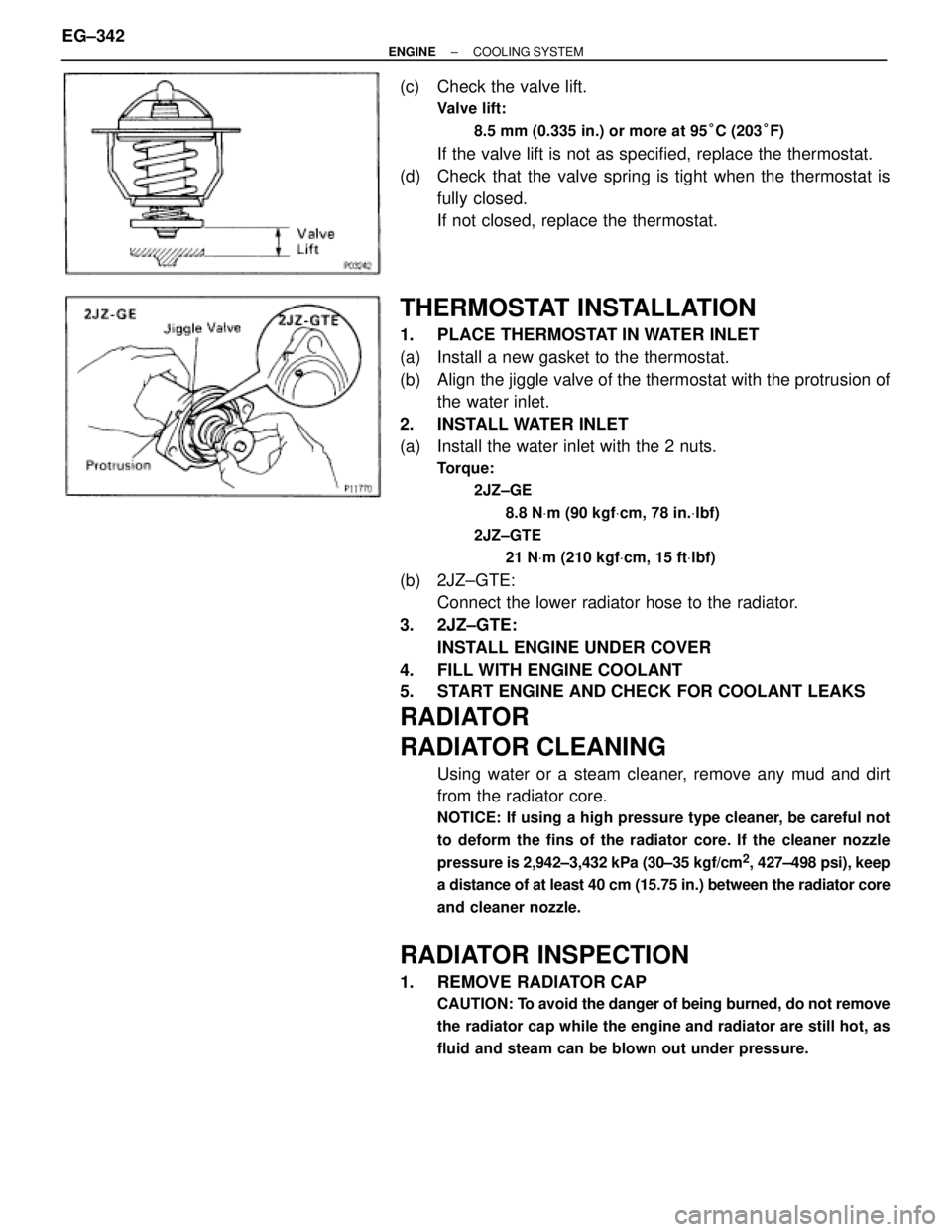
(c) Check the valve lift.
Valve lift:
8.5 mm (0.335 in.) or more at 95°C (203°F)
If the valve lift is not as specified, replace the thermostat.
(d) Check that the valve spring is tight when the thermostat is
fully closed.
If not closed, replace the thermostat.
THERMOSTAT INSTALLATION
1. PLACE THERMOSTAT IN WATER INLET
(a) Install a new gasket to the thermostat.
(b) Align the jiggle valve of the thermostat with the protrusion of
the water inlet.
2. INSTALL WATER INLET
(a) Install the water inlet with the 2 nuts.
Torque:
2JZ±GE
8.8 NVm (90 kgfVcm, 78 in.Vlbf)
2JZ±GTE
21 NVm (210 kgfVcm, 15 ftVlbf)
(b) 2JZ±GTE:
Connect the lower radiator hose to the radiator.
3. 2JZ±GTE:
INSTALL ENGINE UNDER COVER
4. FILL WITH ENGINE COOLANT
5. START ENGINE AND CHECK FOR COOLANT LEAKS
RADIATOR
RADIATOR CLEANING
Using water or a steam cleaner, remove any mud and dirt
from the radiator core.
NOTICE: If using a high pressure type cleaner, be careful not
to deform the fins of the radiator core. If the cleaner nozzle
pressure is 2,942±3,432 kPa (30±35 kgf/cm
2, 427±498 psi), keep
a distance of at least 40 cm (15.75 in.) between the radiator core
and cleaner nozzle.
RADIATOR INSPECTION
1. REMOVE RADIATOR CAP
CAUTION: To avoid the danger of being burned, do not remove
the radiator cap while the engine and radiator are still hot, as
fluid and steam can be blown out under pressure.
EG±342± ENGINECOOLING SYSTEM
Page 1094 of 2543
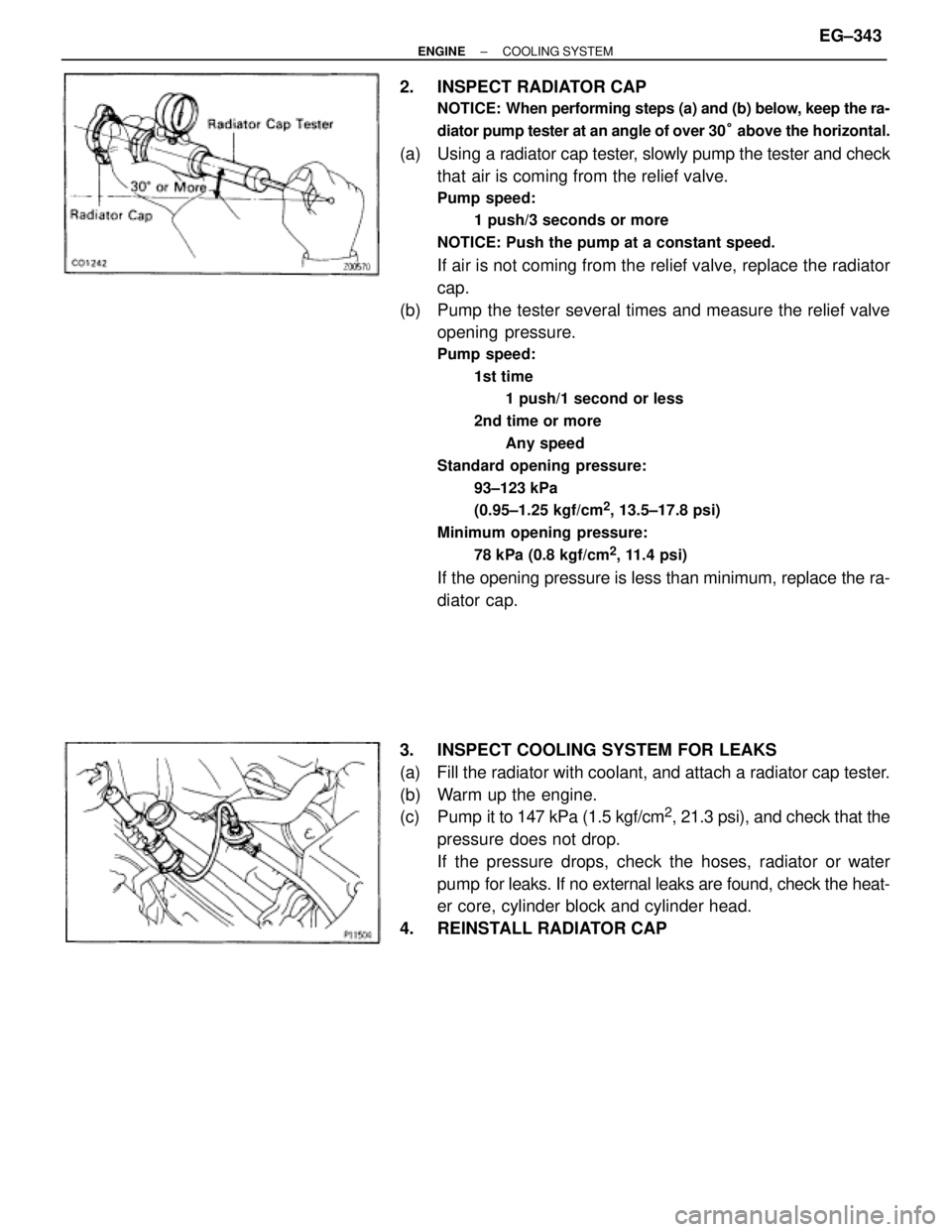
2. INSPECT RADIATOR CAP
NOTICE: When performing steps (a) and (b) below, keep the ra-
diator pump tester at an angle of over 30° above the horizontal.
(a) Using a radiator cap tester, slowly pump the tester and check
that air is coming from the relief valve.
Pump speed:
1 push/3 seconds or more
NOTICE: Push the pump at a constant speed.
If air is not coming from the relief valve, replace the radiator
cap.
(b) Pump the tester several times and measure the relief valve
opening pressure.
Pump speed:
1st time
1 push/1 second or less
2nd time or more
Any speed
Standard opening pressure:
93±123 kPa
(0.95±1.25 kgf/cm
2, 13.5±17.8 psi)
Minimum opening pressure:
78 kPa (0.8 kgf/cm
2, 11.4 psi)
If the opening pressure is less than minimum, replace the ra-
diator cap.
3. INSPECT COOLING SYSTEM FOR LEAKS
(a) Fill the radiator with coolant, and attach a radiator cap tester.
(b) Warm up the engine.
(c) Pump it to 147 kPa (1.5 kgf/cm
2, 21.3 psi), and check that the
pressure does not drop.
If the pressure drops, check the hoses, radiator or water
pump for leaks. If no external leaks are found, check the heat-
er core, cylinder block and cylinder head.
4. REINSTALL RADIATOR CAP
± ENGINECOOLING SYSTEMEG±343
Page 1097 of 2543
RADIATOR REMOVAL
Installation is in the reverse order of removal.
1. REMOVE ENGINE UNDER COVER
INSTALLATION HINT: Start the engine, and check for cool-
ant and A/T fluid leaks.
2. REMOVE BATTERY AND BATTERY TRAY
3. DRAIN ENGINE COOLANT
4. 2JZ±GTE:
REMOVE NO.2 AIR TUBE
5. REMOVE NO.2 FAN SHROUD
(a) Remove the 2 clips.
(b) Disconnect the claw of the No.2 fan shroud from the hook of
the No.1 fan shroud, and remove the No.2 fan shroud.
6. REMOVE AIR CLEANER DUCT
7. 2JZ±GTE:
REMOVE NO.5 AIR HOSE
8. REMOVE LH HEADLIGHT BEAM ANGLE GAUGE
Remove the screw and beam angle gauge.
9. DISCONNECT HOSES FROM RADIATOR
Disconnect these hoses from the radiator:
(1) Reservoir inlet hose
(2) Upper radiator hose
(3) Lower radiator hose
(4) A/T:
2 oil cooler hoses
Plug the hose ends.
INSTALLATION HINT: Check the A/T fluid level.
(See item 21 in Maintenance) EG±346
± ENGINECOOLING SYSTEM
Page 1098 of 2543
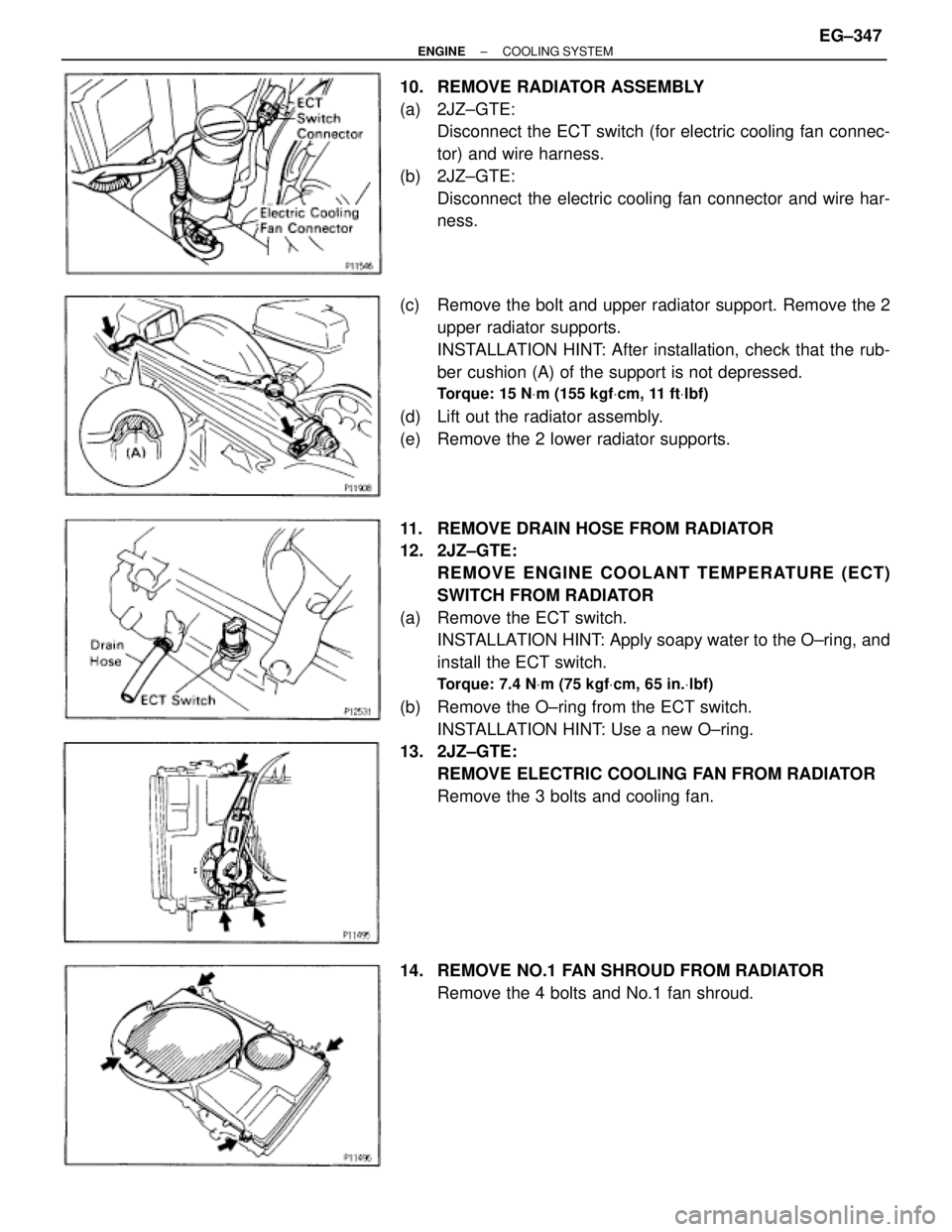
10. REMOVE RADIATOR ASSEMBLY
(a) 2JZ±GTE:
Disconnect the ECT switch (for electric cooling fan connec-
tor) and wire harness.
(b) 2JZ±GTE:
Disconnect the electric cooling fan connector and wire har-
ness.
(c) Remove the bolt and upper radiator support. Remove the 2
upper radiator supports.
INSTALLATION HINT: After installation, check that the rub-
ber cushion (A) of the support is not depressed.
Torque: 15 NVm (155 kgfVcm, 11 ftVlbf)
(d) Lift out the radiator assembly.
(e) Remove the 2 lower radiator supports.
11. REMOVE DRAIN HOSE FROM RADIATOR
12. 2JZ±GTE:
REMOVE ENGINE COOLANT TEMPERATURE (ECT)
SWITCH FROM RADIATOR
(a) Remove the ECT switch.
INSTALLATION HINT: Apply soapy water to the O±ring, and
install the ECT switch.
Torque: 7.4 NVm (75 kgfVcm, 65 in.Vlbf)
(b) Remove the O±ring from the ECT switch.
INSTALLATION HINT: Use a new O±ring.
13. 2JZ±GTE:
REMOVE ELECTRIC COOLING FAN FROM RADIATOR
Remove the 3 bolts and cooling fan.
14. REMOVE NO.1 FAN SHROUD FROM RADIATOR
Remove the 4 bolts and No.1 fan shroud.
± ENGINECOOLING SYSTEMEG±347
Page 1099 of 2543
COMPONENTS FOR DISASSEMBLY AND
ASSEMBLY
RADIATOR DISASSEMBLY
1. REMOVE CUSHIONS FROM RADIATOR EG±348
± ENGINECOOLING SYSTEM
Page 1100 of 2543
2. ASSEMBLE SST
SST 09230±01010
(a) Install the claw to the overhaul handle, inserting it in the hole
in part ºAº as shown in the installation.
(b) While gripping the handle, adjust the stopper bolt so that
dimension ºBº shown in the diagram is 0.2±0.5 mm
(0.008±0.020 in.).
NOTICE: If this adjustment is not done, the claw may be dam-
aged.
3. UNCAULK LOCK PLATES
Using SST to release the caulking, squeeze the handle until
stopped by the stopper bolt.
SST 09230±01010
4. REMOVE TANKS AND O±RINGS
(a) Lightly tap the radiator hose inlet (or outlet) with a soft±faced
hammer and remove the tank.
(b) Remove the O±ring.
5. A/T:
REMOVE OIL COOLER FROM LOWER TANK
(a) Remove the inlet pipes.
HINT: Make a note of the direction to face the pipes.
(b) Remove the nuts, plate washers and oil cooler.
(c) Remove the O±rings from the oil cooler.
± ENGINECOOLING SYSTEMEG±349
Page 1101 of 2543
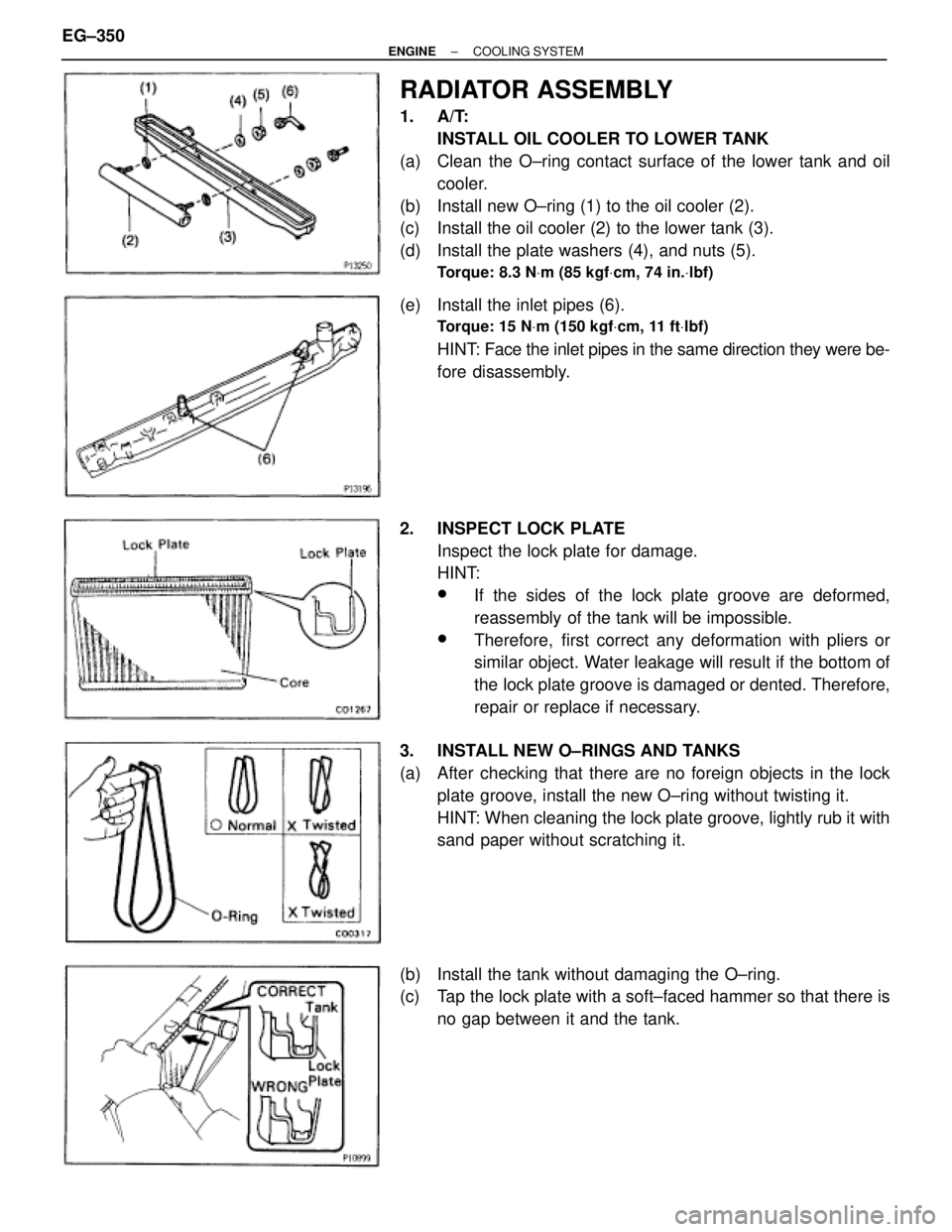
RADIATOR ASSEMBLY
1. A/T:
INSTALL OIL COOLER TO LOWER TANK
(a) Clean the O±ring contact surface of the lower tank and oil
cooler.
(b) Install new O±ring (1) to the oil cooler (2).
(c) Install the oil cooler (2) to the lower tank (3).
(d) Install the plate washers (4), and nuts (5).
Torque: 8.3 NVm (85 kgfVcm, 74 in.Vlbf)
(e) Install the inlet pipes (6).
Torque: 15 NVm (150 kgfVcm, 11 ftVlbf)
HINT: Face the inlet pipes in the same direction they were be-
fore disassembly.
2. INSPECT LOCK PLATE
Inspect the lock plate for damage.
HINT:
wIf the sides of the lock plate groove are deformed,
reassembly of the tank will be impossible.
wTherefore, first correct any deformation with pliers or
similar object. Water leakage will result if the bottom of
the lock plate groove is damaged or dented. Therefore,
repair or replace if necessary.
3. INSTALL NEW O±RINGS AND TANKS
(a) After checking that there are no foreign objects in the lock
plate groove, install the new O±ring without twisting it.
HINT: When cleaning the lock plate groove, lightly rub it with
sand paper without scratching it.
(b) Install the tank without damaging the O±ring.
(c) Tap the lock plate with a soft±faced hammer so that there is
no gap between it and the tank. EG±350
± ENGINECOOLING SYSTEM
Page 1103 of 2543
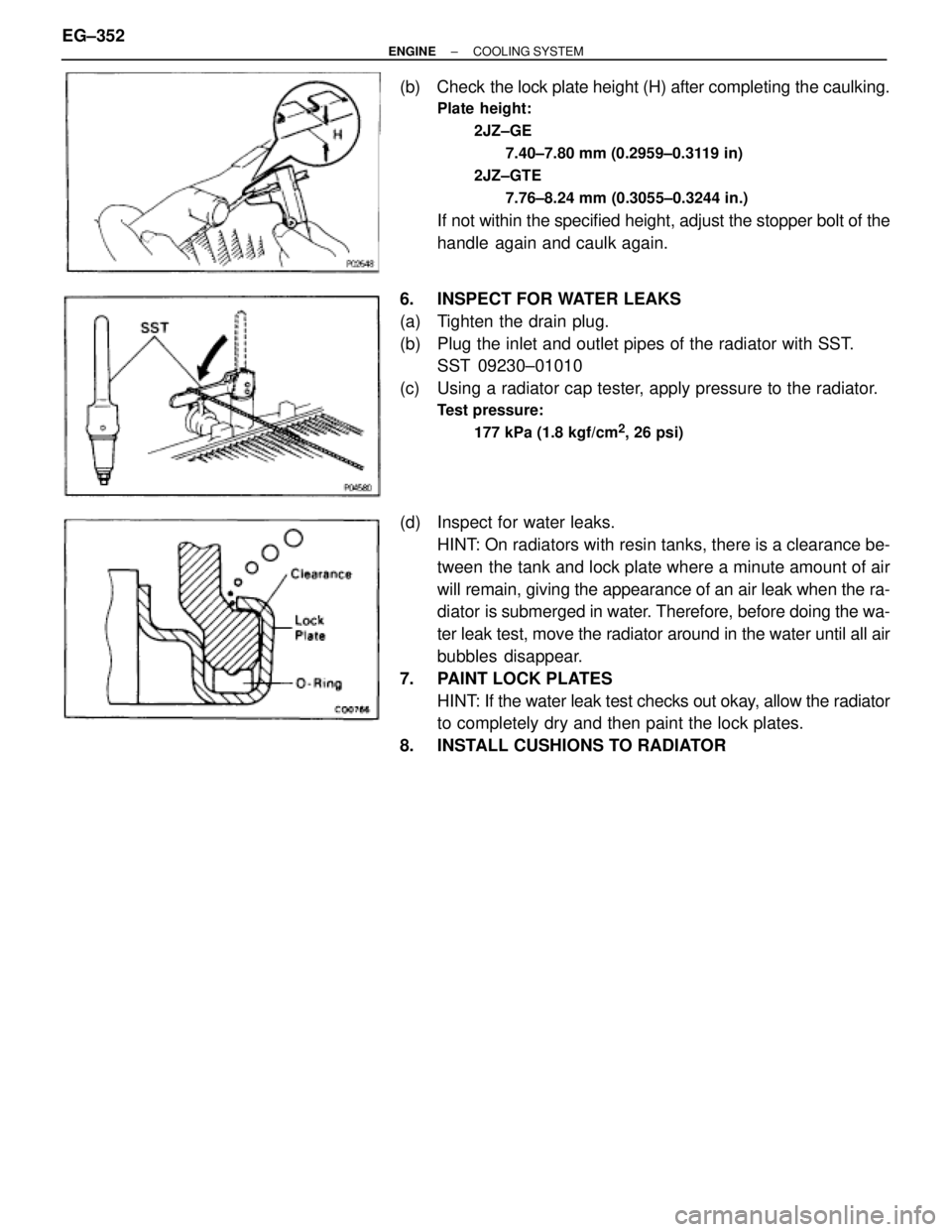
(b) Check the lock plate height (H) after completing the caulking.
Plate height:
2JZ±GE
7.40±7.80 mm (0.2959±0.3119 in)
2JZ±GTE
7.76±8.24 mm (0.3055±0.3244 in.)
If not within the specified height, adjust the stopper bolt of the
handle again and caulk again.
6. INSPECT FOR WATER LEAKS
(a) Tighten the drain plug.
(b) Plug the inlet and outlet pipes of the radiator with SST.
SST 09230±01010
(c) Using a radiator cap tester, apply pressure to the radiator.
Test pressure:
177 kPa (1.8 kgf/cm
2, 26 psi)
(d) Inspect for water leaks.
HINT: On radiators with resin tanks, there is a clearance be-
tween the tank and lock plate where a minute amount of air
will remain, giving the appearance of an air leak when the ra-
diator is submerged in water. Therefore, before doing the wa-
ter leak test, move the radiator around in the water until all air
bubbles disappear.
7. PAINT LOCK PLATES
HINT: If the water leak test checks out okay, allow the radiator
to completely dry and then paint the lock plates.
8. INSTALL CUSHIONS TO RADIATOR EG±352
± ENGINECOOLING SYSTEM